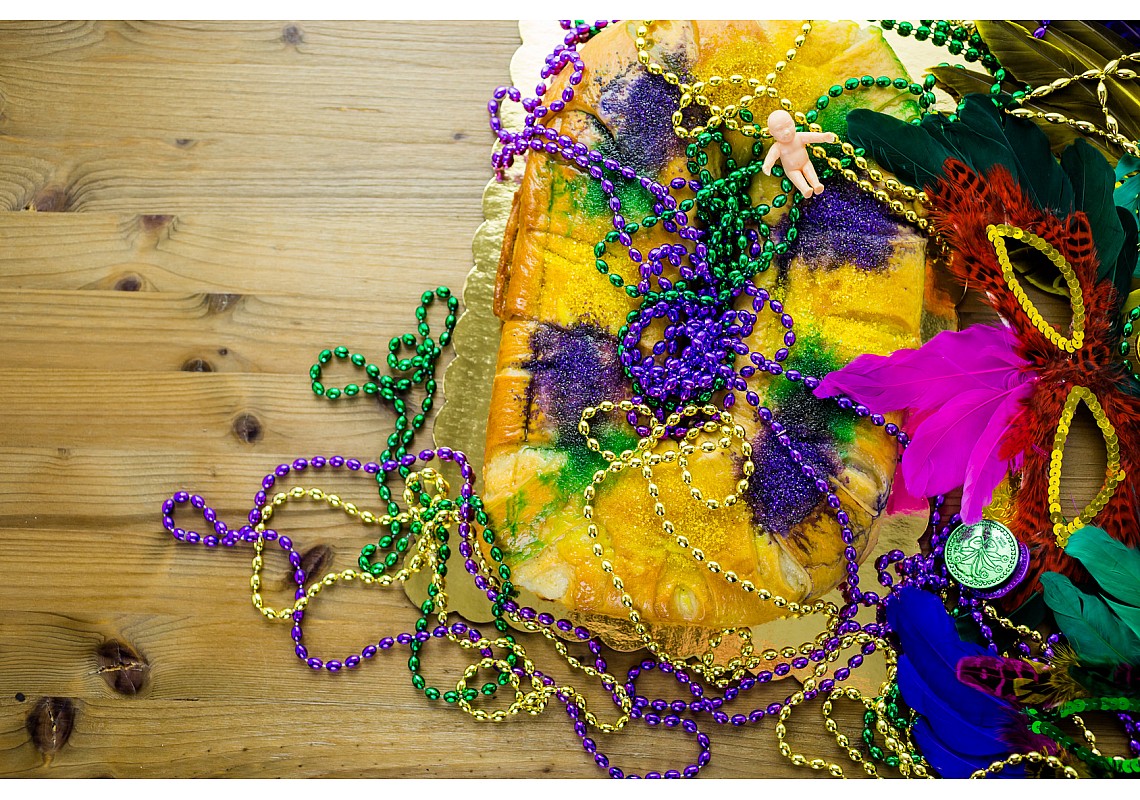History of the Mardi Gras King Cake
- October 10, 2020
- 4097
- 0
- 0
If you’ve had the chance to visit South Louisiana, you know that the culture is quite unlike any other, especially when it comes to food. Cajun Country is filled to the brim with an abundance of culinary traditions, but the Mardi Gras king cake may rank as one of the most popular—and well known. This treat continues to reign supreme during Mardi Gras season for Louisianians and travelers alike. But before you dive hand-first into your own freshly sliced king cake, let’s take a trip back to learn more about how the king cake first came into power.
Long live the king cake.
Like many other aspects of Louisiana culture, king cakes are believed to have originated in France. It is said that around 1870 the treat made its way from France to New Orleans—although some sources say king cakes are much older, dating all the way back to the 12th century. The French were known for their appreciation of sweet, rich foods including delicious pastries. The beignet, so popular in New Orleans today, is another example of a pastry with a French heritage that can be found in almost any Louisiana bakery. In Europe, there was a celebration known as King's Day, or Twelfth Night. Also known as the Feast of the Epiphany, King's Day honored the appearance of the three biblical kings twelve days after the birth of the Christ Child. The original king cake was said to be baked in honor of the pilgrimage made by the Three Kings and served during Epiphany. Much symbolism was attached to the king cake, some of which influenced other elements of culture in Louisiana. The brioche-style cake is typically covered in icing and sugar in colors of gold, green, and purple. This color trio is prominently displayed throughout New Orleans and other Louisiana cities year round. These Mardi Gras colors used on the king cake each hold a specific meaning. Gold was said to represent power. Green stood for faith. Purple symbolized justice. The circular nature of the king cake also has meaning. It is meant to symbolize the circular route the Three Kings used to reach the Christ Child while evading the pursuit of King Herod. It wasn’t until the 19th century that the cake became associated with the popular Mardi Gras holiday.
Why is there a baby in my cake?
The earliest king cakes included a bean, pea or coin that was baked into the cake. As slices were passed out, one lucky celebrant would receive the hidden surprise. This individual was then pronounced King of the festivities and was believed to be the recipient of good luck throughout the coming year. Today, it is more common to find the tiny, plastic figure of a baby inside the king cake. The baby has been used for many years to symbolize the newborn Christ Child and is still believed to confer good luck upon the fortunate reveler who receives it. However, most Cajun Country locals will be quick to let you know that finding the plastic baby also means you’re responsible for providing the next king cake!
A king cake for every occasion!
Today, the Mardi Gras king cake has evolved into a delightful cream or fruit-filled treat that is enjoyed year-round, with peak season from Twelfth Night until Fat Tuesday—the official date of Mardi Gras. The date changes from year to year and always comes 46 days prior to Easter Sunday. Mardi Gras can occur on any Tuesday between February 3rd and March 9th, with most locals enjoying multiple king cakes throughout the Mardi Gras season. The filling of king cakes with cream or fruit is a relatively new practice which can be traced back to the 1980's when local New Orleans bakers began to experiment with various fillings. Today's cakes can be filled with anything from chocolate cream to apples or even praline and boudin fillings! But the king cake love isn’t geographically limited to South Louisiana. In fact, people all over the world are now including king cakes as a part of their own celebration with some bakeries delivering as many as 30,000 cakes to various destinations each year. It doesn’t stop there! Over the years, numerous variations have appeared which include mini-cakes for personal consumption and even a king-cake-flavored vodka. Interested in trying a king cake for yourself? Celebrate Mardi Gras from anywhere by ordering your own king cake today! Whether you opt for a traditional king cake or an unconventional, praline-filled version, king cakes are a great way to experience a glimpse of the unique customs and traditions of the Cajun Country which make life in Louisiana so grand—and tasty!

